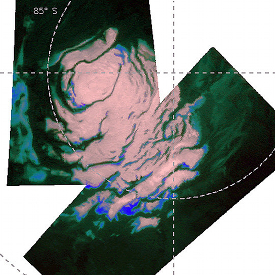Mars Express science highlights:
#4. Probing the polar regions
Early attempts to measure the composition of the polar caps suggested that the northern one could be composed of water ice, while the colder, southern cap was probably carbon dioxide ice. Subsequent observations suggested that the southern ice cap, which exists throughout the martian year, could be a mixture of water and carbon dioxide. However, it was only with the arrival of Mars Express that scientists were able to obtain direct confirmation for the first time that water ice is present at the South Pole.
 |
|
Map of the south pole at Mars, derived from OMEGA infrared spectral images. Credit: ESA/OMEGA. |
This important result was obtained by the OMEGA (Observatoire pour la Minéralogie, l'Eau, les Glaces et l'Activité) instrument on board Mars Express, which measured the amounts of sunlight and heat reflected from the martian polar region.
Analysis of the data clearly showed that the south polar region can be divided into three separate areas. The polar cap itself was found to be a mixture of 85 per cent highly reflective carbon dioxide ice and 15 per cent water ice. The steep scarps, which mark the boundary between the polar cap and the surrounding plains, are made almost entirely of water ice.
The most unexpected discovery was that vast plains of perennial water ice surround the south pole. These permafrost areas consist of a mixture of water and soil which is frozen to the hardness of solid rock in the low martian temperatures. These deposits had remained undetected for so long because the soil-ice mixture is dark and does not reflect light easily. However, by observing the surface at infrared wavelengths, OMEGA could clearly detect the signature of water ice. The discovery hinted that much of the martian surface could harbour larger quantities of water ice than previously thought.
The subsurface structure of the polar ice caps also came under unprecedented scrutiny from the MARSIS (Mars Advanced Radar for Subsurface and Ionosphere Sounding) instrument on Mars Express. The first radar sounder ever to orbit another planet, MARSIS emitted radar waves and detected echoes that were reflected from layered material up to several kilometres below the surface.
MARSIS revealed that both polar ice caps are up to 3.5 km thick. Each polar cap has a core of water ice which is covered by a layer of carbon dioxide ice that is centimetres to decimetres thick. During the warmer summer months most of the carbon dioxide ice sublimates directly to vapour, leaving behind the harder water ice layers.
One important outcome of these studies is that scientists now have a much better idea of how much water there is on Mars, a key factor in understanding the evolution of the planet’s atmosphere and climate. The total amount of water ice contained at the South Pole of Mars makes up the largest water reservoir on the planet today. If this polar ice melted, the entire surface of the planet would be covered by an ocean 11 m deep.
